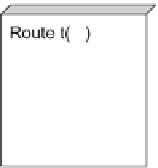Database Reference
In-Depth Information
of the trajectory segments in a temporal point. Thus, we can aggregate
such segments along the different dimensions. Another use of trajectory
aggregation identifies “similar” trajectories and merges them in a class. This
aggregation may come together with an aggregate function, which may be the
COUNT
function in the simplest case, although more complex ones may be
used. Thus, we can ask queries like “Total number of trajectories by class,” or
“List all the trajectories similar to the one followed by truck
T1
on November
25, 2012.” The main problem consists in adopting an appropriate notion
of
trajectory similarity
, through the definition of a similarity measure,
for instance, a distance function. The simplest approach to define similarity
between two trajectories is viewing them as vectors and using the Euclidean
distance as similarity measure. The problem of this technique is that it cannot
be easily applied to trajectories having different length or sampling rate,
and it is not effective in the presence of noise in the data. A typical way
of aggregating trajectories is clustering them together, considering different
distance functions or other characteristics (e.g., same starting point, same
ending point, etc.). Discovering trajectories with the same pattern is another
way of aggregating trajectories.
Fig. 12.8
Extending the Northwind trajectory data warehouse with global fields
In Fig.
12.6
, we associated the field types to the level
State
. This allows
a more ecient manipulation of fields when the focus of analysis is at the
state level. However, as we will see later, for some queries it is necessary to
keep the overall fields covering all the space of interest, without partitioning.
Figure
12.8
extends our example with such
global
fields. Thus, a global
temporal field such as
Temperature
can be seen as a spatiotemporal cube that
associates a real value to any given point in space and time. In this case, such
fields are related to facts or dimensions through spatial or spatiotemporal
operations.














































Search WWH ::

Custom Search